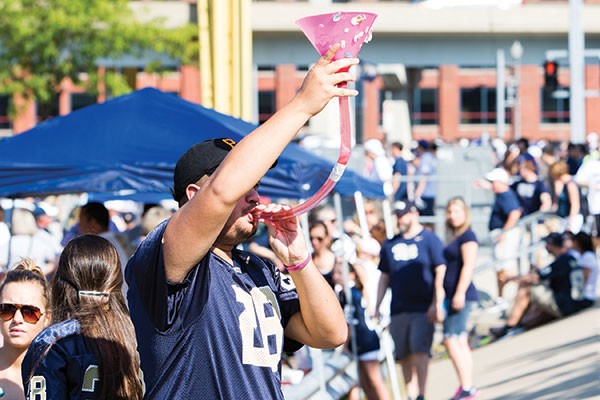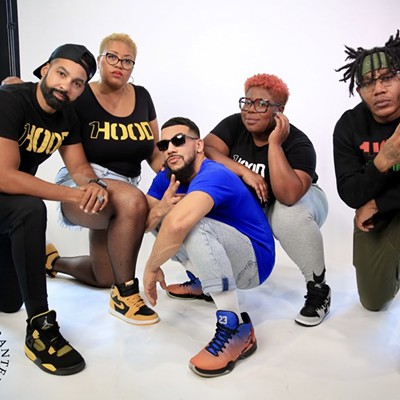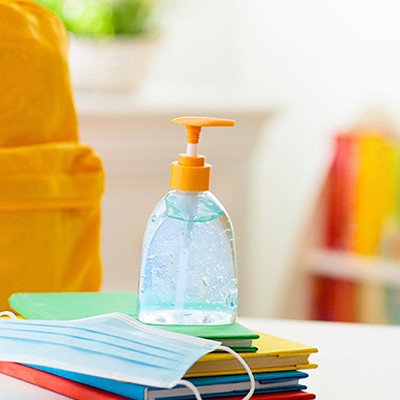First there was Animal House, the 1978 film comedy following a group of college fraternity members. It’s the movie that made toga parties popular and made college synonymous with drinking.
But Animal House was only the beginning. What followed were a slew of alcohol-infused party movies, including American Pie (1999) and Superbad (2007) — coming-of-age films that follow graduating high school students poised to enter a world of hedonistic exploits.
“We’re in the American Pie era,” says Antonio Blundo, a University of Pittsburgh senior. “All these movies have come out that constantly portray college as a place to drink. It’s what the mainstream media really pushes college as.”
A recent study found that college students are more likely to drink than are 18- to 22-year-olds who aren’t in college. The study, released this past summer by the U.S. Substance Abuse and Mental Health Services Administration, used data from a federal survey of about 10,000 young adults.
Sixty percent of full-time college students said they are current drinkers, compared to 50 percent of those who weren’t in college. And 38 percent of college students surveyed said they engaged in binge-drinking, compared to 33 percent for non-college students.
According to the Centers for Disease Control and Prevention, binge-drinking is “a pattern of drinking that brings a person’s blood alcohol concentration (BAC) to 0.08 grams percent or above.” (That’s about five drinks in two hours for men, and four drinks for women.) The makers of the AlcoMate Revo digital personal breathalyzer recently offered Pittsburgh City Paper one of their devices to test and use. (We’re not experts in administering breathalyzer tests.) For this story, we interviewed local college students to find out why they think their classmates are more likely to drink than are peers who are not matriculating. After each interview, we administered an unofficial BAC test. (We also talked to some students who weren’t intoxicated.)
Based on our anecdotal evidence, the spirit of college drinking appears alive and well, and the usual “just say no” approach isn’t hitting home for many. In an effort to protect students, several Pittsburgh-area colleges and universities are developing new and engaging education programs to make the alcohol-abuse discussion livelier.
“I don’t think it’s helpful to just tell people to just say no to alcohol,” says Blundo, who spoke to CP by phone and was not breathalyzed. “I think it’s OK to stop lying to ourselves. I think it’s OK to say realistically, ‘I’m going to drink tonight.’ I think people should learn to do it responsibly.”
At 10 p.m. on Sept. 9, the night before the big Pitt-Penn State football game, we found ourselves at Peter’s Pub, the popular Oakland watering hole. The bar was crowded and noisy, and the floor was sticky and strewn with popcorn.
Breathalyzer in hand, this reporter spoke to students and recent grads about why they think college students are more prone to binge-drinking than their peers. While all were willing to take the test to see if they were above or below the legal limit of .08, few were willing to provide their full names.
“We’re reckless,” said Dan K. (whose BAC was .41 — and yes, that’s five times the binge-drinking level). “I think social media has a big effect because we’re trying to live up to the standards we see. I go onto Instagram and I see pictures about being this fucked up and this fucked up. We’re looking for acceptance. Everyone wants to be like the next person. It’s like trying to bring movies and TV shows to life. It’s all bullshit.”
“I think there’s a culture of drinking in college no matter where you go,” said Carlos Sierra (BAC .32) “Nine times out of 10 you make friends that want to drink.”
“If you’re in college, everyone drinks,” said Michael K. (BAC .37). “There’s more stress because of doing school work. College is the best time of your life and you’re supposed to do that. I drank before college. Everyone basically did.”
Several of the students interviewed said the alcohol education that colleges provide isn’t engaging. Michael K. said freshmen students had to take a “stupid six-hour thing that took forever.”
“They taught us unrealistic stuff like have one drink every hour,” said Peter O’Donnell (BAC .15). “If I gave you a drink, how long would it really take you?”
“To be honest, I don’t think I’ve gotten that much education about drinking,” said Sierra. “I was taught you go to college to study, but you also drink. It’s part of college.”
While those interviewed said alcohol education programs didn’t really influence them, they said getting caught for underage drinking can be a real wake-up call. Cole Z. (BAC .16) who turned 21 last week, said that if you get caught drinking underage, you have to take a class, and it ends up costing $1,000 for the ticket and other fines.
“A lot of people turn 21 in college and they’re like, ‘I’m finally going to do it.’ But even before that, the younger kids see it and they say, ‘I want to do it too,’” Cole Z. said. “Plus it’s a stereotype because of the media. College has always been like this because the media stereotypes it.”
But once you graduate, the party’s over, say recent college graduates. “I have more things to do now, more responsibility,” said Nina S. (BAC .07), who graduated this past spring.
Lisa P. (BAC .01), another recent grad, said binge-drinking derives from peer pressure. “It’s just like there’s nothing else to do. Everyone is doing it. We’re so stressed. It’s just a release.”
Despite the current climate, there are several barriers to alcohol abuse from the time a freshman sets foot on a local college campus or university. Firstly, most of Pittsburgh’s universities have dry campuses.
“Carlow University is a dry campus,” Drew Wilson, director of media relations for Carlow, wrote in an email to CP. “Students and their guests are not to have drugs or alcohol on their person or in the residence hall. Students found in violation of this policy will face immediate disciplinary action from the university, as well as possible sanctions consistent with any federal, state or local laws for a drug or alcohol violation.”
And at Carlow, first-year students are required to complete the My Student Body alcohol-awareness survey online before they arrive on campus. The survey gives college administrators data to target, evaluate and strengthen prevention initiatives related to drug and alcohol abuse and sexual violence.
“During first-year orientation (held before the first week of classes), Carlow enlists speakers from the organization CampuSpeak to talk to students about the dangers of alcohol and drug use,” writes Wilson. “The resident assistants in the residence halls address the topic of alcohol and drug use and abuse [and other topics] during their monthly meetings with the students under their supervision.”
But Carlow and other universities are trying to educate students further by providing programs that are more engaging than sitting in a lecture hall, learning alarming statistics about drug and alcohol abuse that don’t appear to actually frighten anyone.
“In October each year — in conjunction with the university’s police department — students attend a seminar where there is a go-kart and course set up,” Wilson wrote. “The students are allowed to ride the go-kart with and without goggles that simulate how it feels to be impaired by drugs and alcohol. This gives them a firsthand appreciation for how drugs and alcohol may impair their senses and motor skills.”
And Keith Paylo, vice president of student affairs for Point Park University, says his university has also developed new and fun ways to engage students.
“Our first big event of the year — we’ve had 400 students at it — called Pioneer Pub, is meant to start the year off with alcohol education. It’s about making sure students, especially new freshmen, understand how much you can drink — how many beers or shots does it take to get drunk — because they’ve never been exposed to that.”
Paylo says it’s important for students to receive a well-rounded education that includes developing social skills and understanding the dangers of alcohol and drug abuse.
“Our younger generation seems to be exposed to a lot of things in high school, but the freedom’s not there — mom and dad are still around,” says Paylo. “So like any other college or university when the parental guidance is away, we feel an obligation to explain to students there’s a responsible way to do this and an irresponsible way. Education is also outside of the classroom, and that’s key to us.”
Even for those under the legal drinking age, Paylo says a “just say no” approach isn’t realistic because it leaves students at risk.
“They don’t understand the dangers of binge-drinking,” Paylo says. “We can’t just say we know students are going to drink underage. So our goal is, if it’s going to happen, at least we should educate students on the best way to do it. It’s not that we say they should. We do remind them that it’s illegal to do that. But it’s irresponsible to believe that’s going to stop students.”
At the University of Pittsburgh, college administrators are using technology to ensure that students drink responsibly. A team at Pitt, lead by Dr. Brian Suffoletto, recently developed PantherTRAC, a text-message-based intervention system.
“This is the second year that we are using the text-messaging service to try to reduce binge-drinking,” Joe Miksch, Pitt’s interim director of university news, wrote in an email to CP. “Our ‘PantherTRAC’ program is an evidence-based, text-messaging program intended to [bolster] other methods of alcohol intervention. … It is a computer program that periodically sends queries and support messages through mobile-phone texts to the user (our students).”
These messages include not just education about the dangers of drinking, but also motivational statements and behavioral tools to promote low-risk drinking and help students handle peer pressure.
“PantherTRAC helps students self-monitor their drinking intentions and behaviors, assists in goal-setting that strives for lower risk drinking and increases achievement of better drinking choices,” Miksch wrote. “It is completely confidential, which contributes to the 89 percent completion rate by our students. Initial trials were very convincing; reports of binge drinking decreased to less than 10 percent of sanctioned participants.”
Miksch says that because of the success of initial trials, the program was introduced to all incoming freshmen this fall.
And while the programs are a good start, making a dent in the number of students drinking heavily will continue to be an uphill battle. On the night CP was at Peter’s Pub, for instance, there were as many parents and alumni drinking as students. The scene the next day, during tailgate parties at Heinz Field, was similar. And the reason is obvious, according to Michael K., the student who blew the .37 on the AlcoMate: “People drink because it’s a drug and it makes you feel good."



















